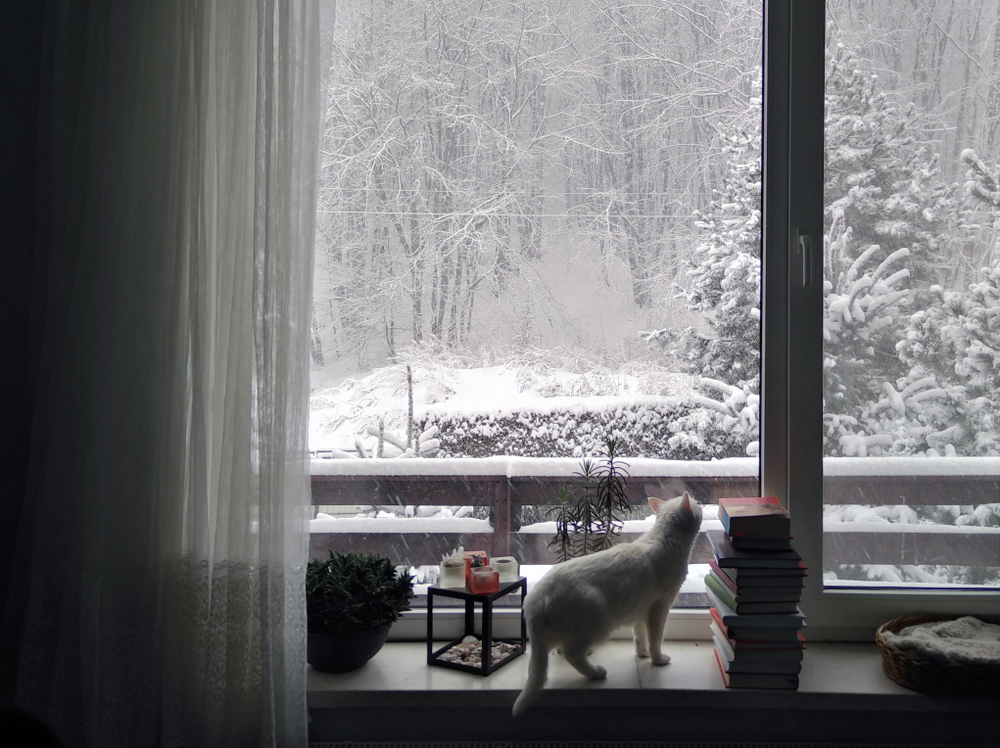10 Winter Energy-Savings Tips

When the weather turns chilly, your first instinct might be to turn the thermostat to surface-of-the-sun temperatures. But did you know that doesn’t heat your home any faster? Your home warms at the same rate regardless of the temperature you set, whether it’s 80 degrees or 72 degrees. If you’re trying to be more conscious of your energy use during the winter months and want to save money on your utility bills, there are a few ways to make that happen.
Keep these winter home energy-saving tips in mind as you head into the frosty winter months to save on your energy costs and create a more energy-efficient home. Many of these suggestions will even deliver long-term benefits you can enjoy even after the last snowfall.
1. Let the sunshine in
The sun can act as free heat for your home, so make sure you take advantage of this natural furnace. Draw your curtains on south-facing windows during the day to let the sunshine heat your living areas. Utilizing south-facing windows is an important part of “passive solar design,” a type of home design that harnesses the natural energy the sun provides to keep the home at a more consistent, warm temperature.
Pro tip: Don’t forget to close the curtains when the sun goes down to retain as much heat as possible. Ideally, you should invest in thick, insulated curtains which will help your home stay warmer longer.
2. Switch your ceiling fan’s rotation
As you might already know, hot air rises which is why when you’re heating your home during the winter, warmer air can escape into the upper areas of your property. Keep that heat near your living spaces by reversing your fan’s blades so they turn clockwise instead of counterclockwise. Doing so will force the hot air back down and help keep the temperature consistently warmer in your home.
3. Seal any drafts by checking windows and doors for air leaks
Drafts and air leaks can add hundreds to your energy bill each year. You may want to upgrade to energy-efficient windows and doors as a long-term solution to your insulation issues, but in a pinch, you can rely on a budget-friendly alternative like a clear plastic film sealed tightly around your window frames.
Find and fix air leaks in your home by conducting a DIY energy audit. Even the most energy-efficient HVAC system can’t heat your home properly if your home has air leaks and drafts. Where heat is escaping, you can add caulking or weather-stripping.
Areas of your home where you may want to inspect for air leaks include:
- Windows
- Doors
- Baseboards
- Electrical outlets
- Plumbing vents
- Recessed lighting
This energy efficiency tip for winter can also be just as beneficial during the summer when you’re using your air conditioning regularly.
4. Turn down the heat
One of the top winter energy-saving tips is also the simplest: The US Department of Energy recommends turning down your thermostat by at least 10-15 degrees when you’re asleep or out of the house. Over the year, this can save up to 10% on your heating bill.
Speaking of heat, it’s a good idea to invest in a smart thermostat that automatically keeps your temperature within a comfortable range without you needing to lift a finger. This upgrade can cut your heating bill by around 12% annually. It’s an investment that will continue to help you conserve energy into the warmer months when you start using your air conditioning.
Pro tip: You don’t need to take this tip to an extreme and sleep or live in freezing temperatures inside your home. You should consider keeping the temperature above a certain level to avoid your pipes freezing if you live in a colder climate.
5. Schedule regular maintenance of your heating system
To best prepare for the cold weather months, it’s prudent to schedule a routine maintenance service for your HVAC system. As a general rule of thumb, you should replace your filter once a month or as needed for heat pumps or furnaces. For wood and pellet-burning heaters, you should clean the flue vent regularly and clean the inside of the appliance with a wire brush from time to time to make sure your home is heated efficiently.
If you feel like your heating system isn’t working efficiently or is reaching the end of its lifespan (15-20 years), you might want to consider a full HVAC replacement.

6. Maintain your fireplace
There are a few ways to make your fireplace more energy-efficient during the winter months. For instance, you can replace your old wood-burning fireplace with an EPA-certified model. As a bonus, you may even receive a tax credit for this upgrade because some states offer this incentive.
If you find that you don’t use your fireplace, you may want to plug and seal the chimney flue to avoid letting warm air leak out. If you do use it, check the seal on the fireplace flue damper to make sure it fits snug to avoid drafts. Add C-shared grates to encourage the fireplace to draw in cold air and circulate hot air back into the room. You can also add caulking around the hearth to make sure the heat from the fire is retained.
Pro tip: Keep your fireplace damper closed unless you have a fire actively burning. Keeping a fireplace damper open is essentially the equivalent of keeping a window open in your home since it allows hot air escape.
7. Lower your hot water temperature
Make sure that your maximum hot water temperature is set to 120 degrees. This will ensure you’re not wasting heat through your water and keep you from scalding injuries.
Most household water heater thermostats are automatically set to 140 degrees, which is typically much higher than necessary. To adjust the heat, you’ll want to simply turn the dial on the water heater. If you want an accurate reading of the temperature, you can use a thermometer to get an exact measurement.
8. Switch to LED bulbs
Removing your CFL bulbs and switching them out for LED light bulbs is an easy energy-efficient replacement that’s relatively low-cost LEDs, uses at least 75% less energy, and lasts 25 times longer than traditional incandescent bulbs.
And don’t forget about holiday lights. LED holiday string lights last longer than traditional holiday lights and use significantly less energy.
9. Avoid your exhaust fans unnecessarily
You can still use your exhaust fans, of course, but focus on using them sparingly and make sure you turn them off when not in use. They can be a major culprit of heat loss during the winter if you’re prone to leaving the exhaust fans on in your kitchen and bathroom.
10. Decorate with intention
As we mentioned previously, investing in thick curtains can help your home retain more heat but there are other cozy additions you can leverage to retain more heat as well. For example, thick rugs and wall hangings can help your home retain more heat. If you’re ready to take on a bigger project, you can also add more insulation to your walls and attic.
Keep throws and blankets on couches in living areas you can easily access to keep yourself and loved ones warm without needing to adjust the thermostat.
Stay warm and stay under budget
It can be expensive to run your heater in the winter but by learning how to create an energy-efficient home with our winter energy-saving tips, you can have a smaller bill and feel comfortably warm all winter long. If you decide to make a larger investment like replacing your furnace or upgrading to storm windows to see a larger impact on your long-term savings, you may be able to qualify for PACE financing through Ygrene. Get started on your energy-efficient home improvements with Ygrene and check your eligibility today!




